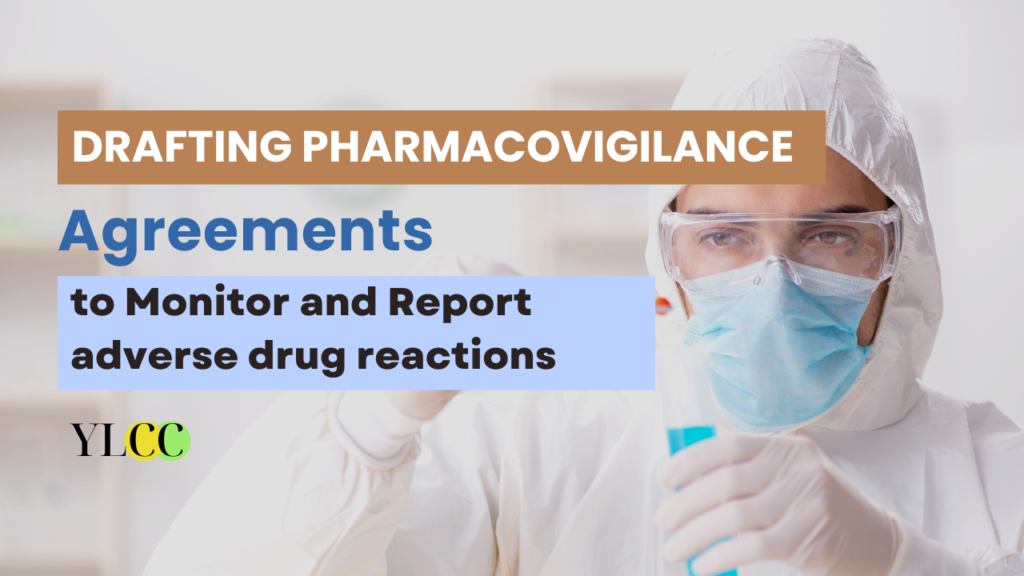
INTRODUCTION
In an evolving landscape of pharmaceutical development and usage, pharmacovigilance is indispensable to identify and mitigate potential risks associated with medicinal products, and through pharmacovigilance, healthcare professionals, regulatory authorities, pharmaceutical companies, and patients collaboratively contribute to the continuous assessment of drug safety.
One of the fundamental mechanisms ensuring the success of pharmacovigilance efforts is the establishment of well-structured pharmacovigilance agreements. These agreements provide a formal framework for various stakeholders to collaborate efficiently in monitoring, collecting, and reporting adverse drug reactions (ADRs). The significance of such agreements lies in their ability to streamline the flow of crucial safety information between parties involved which leads to improved patient safety and better-informed healthcare decision-making. These agreements outline the responsibilities and obligations of each party, facilitating seamless communication and coordination in the event of any drug safety concerns.
Team YLLCC is here to provide a comprehensive guide on drafting pharmacovigilance agreements to monitor and report adverse drug reactions effectively, highlight the role of pharmacovigilance in ensuring drug safety and public health and focus on the importance of pharmacovigilance agreements as effective tools for collaboration and information exchange among stakeholders!
REGULAR FRAMEWORK AND GUIDELINES FOR PHARMACOVIGILANCE
Pharmacovigilance operates within a streamlined regulatory framework and adheres to international guidelines to ensure consistent and standardized practices worldwide. The World Health Organization (WHO) and the International Council for Harmonisation of Technical Requirements for Pharmaceuticals for Human Use (ICH) have established guidelines and principles to govern pharmacovigilance activities. The following are the guidelines:
- WHO Guidelines: The WHO provides overarching guidelines for pharmacovigilance and signifies the importance of collaborative efforts between member states to monitor and report adverse drug reactions. These guidelines outline the minimum requirements for national pharmacovigilance systems and encourage information sharing to enhance global drug safety.
- ICH Guidelines: The ICH has developed several guidelines addressing pharmacovigilance practices, such as ICH E2D (Post-Approval Safety Data Management) (see here) and ICH E2E (Pharmacovigilance Planning) (see here). These guidelines focus on various aspects, including risk management planning, signal detection, and aggregate safety reporting.
THE KEY ELEMENTS OF THE PHARMACOVIGILANCE AGREEMENT
A well-structured pharmacovigilance agreement serves as a foundational document that outlines the terms and conditions governing the monitoring, reporting, and management of adverse drug reactions (ADRs) between relevant stakeholders. The agreement should encompass the following essential components:
Purpose and Objectives:
- You should clearly state the primary purpose of the agreement, which is to facilitate effective pharmacovigilance activities for the specific medicinal product or product group.
- Define the key objectives, such as ensuring patient safety, complying with regulatory requirements, and promoting timely reporting and assessment of ADRs.
Scope and Duration:
- Clearly define the scope of the agreement, specifying the medicinal product(s) or drug category to which it applies.
- You should indicate the geographical scope, specifying the countries or regions where pharmacovigilance activities will be conducted under the agreement.
- Define the duration of the agreement, including the start date and end date or any renewal conditions.
Parties Involved:
You should list all parties involved in the pharmacovigilance agreement, including but not limited to:
- The pharmaceutical company or marketing authorization holder is responsible for the product(s).
- Regulatory authorities or competent authorities responsible for drug oversight.
- Local pharmacovigilance centres or affiliate offices are involved in safety data collection and reporting.
- Contracted service providers responsible for specific pharmacovigilance activities, if applicable.
Always remember to clearly identify the legal entities and their contact information.
Roles and Responsibilities:
Detail the specific roles and responsibilities of each party involved in the agreement.
For the pharmaceutical company:
- Responsibility for collecting, processing, and evaluating safety data.
- Timely submission of safety reports to regulatory authorities.
- Development and implementation of risk management plans, if required.
For regulatory authorities:
- Reviewing safety data and taking appropriate regulatory actions based on risk assessments.
- Providing guidance and support to pharmaceutical companies regarding pharmacovigilance activities.
For local pharmacovigilance centres or affiliates:
- Collection, processing, and reporting of safety data to the respective regulatory authorities and the pharmaceutical company.
- Facilitating communication between healthcare professionals and the pharmaceutical company regarding ADRs.
Data Collection and Reporting:
- Specify the methods and frequency of safety data collection and reporting.
- Describe the format and content requirements for periodic safety reports, expedited reports, and other safety-related communications.
Signal Detection and Evaluation:
- Outline the procedures for signal detection, including methods for analyzing safety data and identifying potential safety concerns.
- Describe the processes for signal evaluation, including causality assessment and follow-up actions.
Risk Management and Communication:
- You should include provisions for risk management activities, such as risk minimization measures and risk communication strategies.
- Address how safety information will be communicated among the parties involved and to relevant stakeholders.
Confidentiality and Data Protection:
You should always ensure that appropriate measures are in place to protect the confidentiality of safety data and comply with data protection regulations.
Amendments and Termination:
- Remember to establish a process for making amendments to the agreement, if necessary, and how any changes will be communicated and implemented.
- Define the conditions under which the agreement can be terminated by either party and the responsibilities during the termination process.

REPORTING REQUIREMENTS FOR ADRs
Reporting adverse drug reactions (ADRs) is an important aspect of pharmacovigilance, as it enables the timely detection and assessment of potential safety concerns associated with medicinal products. The process for reporting ADRs involves specific data collection and adherence to timelines and methods for effective communication with the relevant authorities and the pharmacovigilance system.
Process for Reporting ADRs:
- Healthcare Professionals and Patients: Healthcare professionals, such as doctors, nurses, and pharmacists, are encouraged to promptly report any suspected adverse reactions observed in patients during drug therapy. Patients can also report ADRs directly to healthcare professionals or national pharmacovigilance centres.
- Pharmaceutical Companies: Pharmaceutical companies are responsible for collecting and evaluating safety data from various sources, including healthcare professionals, patients, and scientific literature. They must conduct a thorough assessment of the reported ADRs to determine their causality, seriousness, and potential impact on the drug’s risk-benefit profile.
Specific Data to be Collected:
- Patient information: Age, gender, medical history, concomitant medications, and relevant medical conditions.
- Drug information: Name of the medicinal product, dose, route of administration, batch number, and treatment duration.
- Adverse event details: Description of the adverse event, its onset date, severity, and outcome.
- Suspected/Concomitant medications: Information about other drugs the patient is taking, which might have contributed to the reaction.
- Relevant medical history: Any pre-existing medical conditions that may have influenced the occurrence of the ADR.
Timelines and Methods for Reporting ADRs:
- Expedited Reporting: Serious and unexpected ADRs should be reported expediently, usually within a short timeframe (e.g., 15 days). The specific timelines for expedited reporting may vary depending on local regulatory requirements. The reports are generally submitted directly to the relevant national regulatory authorities and pharmacovigilance centres.
- Periodic Safety Reports: Pharmaceutical companies are required to submit periodic safety reports (PSURs) at predefined intervals, summarizing safety data over a specified period. The reporting frequency and content of PSURs are determined based on the drug’s characteristics and regulatory guidelines.
- Electronic Reporting: Electronic reporting through dedicated pharmacovigilance databases or regulatory portals is increasingly common, ensuring faster and more efficient communication.
- MedWatch or Yellow Card Schemes: In some countries, healthcare professionals and patients can report ADRs through specific reporting systems like MedWatch (in the United States) or Yellow Card Scheme (in the United Kingdom).
Therefore, it is essential for all stakeholders, including healthcare professionals, patients, and pharmaceutical companies, to follow the prescribed timelines and use appropriate reporting methods to ensure that ADRs are promptly communicated to the relevant authorities because effective reporting enables continuous monitoring of drug safety, early detection of potential risks, and implementation of necessary risk mitigation strategies to safeguard patient health. Additionally, reporting contributes to the accumulation of comprehensive safety data, supporting ongoing pharmacovigilance efforts and promoting public confidence in the safety of medicinal products.
CONCLUSION
Pharmacovigilance agreements serve in the collaborative efforts between pharmaceutical companies, regulatory authorities, healthcare professionals, and other involved parties. These agreements define the scope, responsibilities, and procedures for monitoring and reporting ADRs, fostering effective communication and coordinated action in addressing drug safety concerns. The importance of well-drafted pharmacovigilance agreements cannot be overstated. These agreements lay the foundation for a robust pharmacovigilance system, facilitating the early detection of potential safety issues and the timely implementation of risk mitigation measures. Additionally, these agreements contribute significantly to drug safety and patient welfare by fostering efficient communication and cooperation among stakeholders
Ensuring drug safety is not just a legal requirement but a moral obligation that demands a collective commitment from all involved in the healthcare ecosystem. With well-structured pharmacovigilance agreements in place, stakeholders can strengthen their pharmacovigilance practices, thereby building a safer and more trustworthy healthcare system for patients worldwide.
Disclaimer: This article is for information purposes only. You are advised to consult a legal professional for drafting such crucial documents for your business.
This article has been written by Team YLCC. For any other queries, reach out to us at: queries.ylcc@gmail.com






